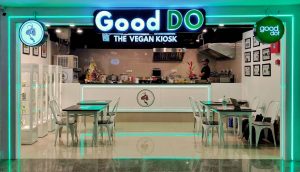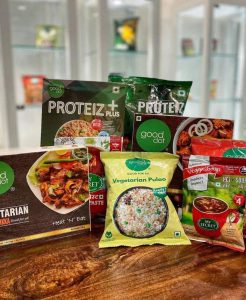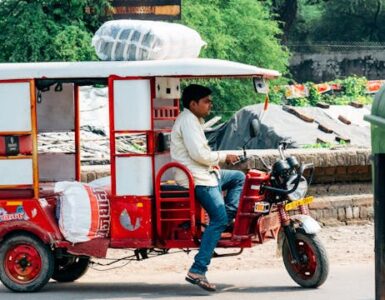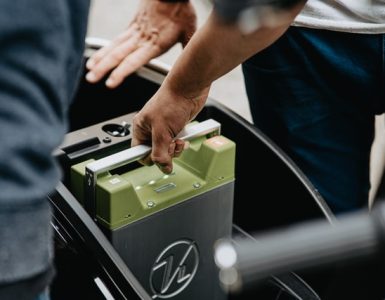A simple analogy that I have used for plant-based meat or alternative meat is Ctrl C and Ctrl V – where C is Chicken and V is Vegetarian. When you copy chicken to a make vegetarian meal. To expand it, making plant-based food that is similar in taste and looks to meat-based food.
Over the last few years, significant progress has been made in research, investments, and most importantly evolving food consumption preferences towards plant-based meat alternatives.
As per reports and market research, the market for alternative meat probably will reach upwards of $15 billion globally in the next 5 years.
The main drivers of the growth are concerns about animal welfare, environmental damage which happens due to livestock farming, health, and food taste.
We sat with Abhinav Sinha, co-founder of GoodDO which is an offshoot of GoodDot, in plant-based meat restaurant space.
Not to be confused with an Indian film director Anubhav Sinha known for his much-acclaimed movies like Mulk, Article 15, and Thappad. Abhinav Sinha is also a Director (Pun intended 😊), making the plants act like Meat, making the consumer dance to the tunes of a healthier diet, and setting perfect cinematography in highly affordable, vegan plant-based restaurants.
Just to set it right, Abhinav is CEO and co-founder of GoodDO
Here is an edited version/excerpts of our conversation with Abhinav, for the full discussion please watch the video.
Tell us about your company?
We are two different companies with a similar set of founders who work very closely together. We’ve got a company called GoodDot which manufactures plant-based meat. This is a company based out of Udaipur.
Here we basically use high-tech food processing and manufacturing to convert plant proteins into a form that then resembles animal proteins in animal meat. It still gives the same experience without really hurting an animal; that was the basis for GoodDot. It was in 2016 when we formed that company and got into a plant-based meat segment.
Currently, you can find GoodDot in RCM stores and around the country on Amazon; we export within South Asia and shortly we’ll be moving to Canada and other countries.
The second company, the one that I head is called GoodDO that is India’s first and largest chain of vegan QSRs (quick-service restaurants).
Plant-Based Meat. Can you explain it?
We basically break apart the proteins or de-nature the proteins and then realign or renature them in a different way to get the texture and feel of meat. The primary ingredients are high protein components like soy protein, wheat, and so on to create these unique experiences.
For us, the drive behind this move was to help reduce animal cruelty and promote compassion not by telling people that they should eat less meat or eat less of animal-based products but by providing a very accessible, unique, fun, healthier alternative to animal meat.
Tell us more about your plant-based meat restaurant GoodDO?
At GoodDO we have small outlets that focus on plant-based meats and completely vegan offerings. Vegan as you know means no animal products – no egg, no meat, no dairy, no honey. We use complete plant-based ingredients, completely vegan ingredients to create unique products.

If you look at the vegan restaurant space most of them that serve vegan food primarily cater to the high-end relatively expensive proposition – soups and salads and whole-food – plant-based stuff which is all very healthy and great. I love that as well but that is not accessible to all. We, Indians, love our paratha, our fried stuff, and other fun things.
“So, we decided to not restrict our offerings to the very expensive and super healthy offerings only. Instead, to make veganism mainstream, we created a fast-food format, a quick-service format, where we have everything from a fried chicken alternative to a paratha-butter chicken combo, without butter or chicken! We have our super popular Smoky Keema Pav and UnMutton Biryani as well. In addition, we have Vegicken Gurbers (our take on Burgers) and Rolls as well, to round-off a wide variety of dishes.
In a quick-service format, it’s a healthier version of the meat alternative that we get. That is GoodDO.
GoodDO!! An interesting name.
There are two bits again – GoodDot – we have the logo which is a green circle with the lettering good dot inside. What we’ve said is that in Indian food packaging we have either a red dot or a green dot indicating a non-vegetarian or a vegetarian product. So we’ve taken the green dot and we said we’re trying to do good through it and our products are good for you, good for the earth and good for animals which are good for all, So we call that dot a good dot and that’s our logo.

And the name – GoodDO, on the other hand, it happened fortuitously, where one of our co-founders, Abhishek, who is also my brother, was going to the factory one day about a couple of years back. He crossed a meat shop and something inside him stirred. He came around and he bought all the animals in that butcher shop right there – a bunch of chickens and one goat. We created a mini sanctuary for them outside the factory and the guys in the factory you know had a huge liking to the goat and as a term of endearment, they named him Guddu.
A little later in that year, we thought of coming up with an experience centered around our products and after several permutations and combinations, we said that let us save this beautiful goat whose name is Guddu, and let’s just use give him a chance to save his fellow friends. So we named this whole enterprise after Guddu and we reverted it to GoodDo so it connects with GoodDot, connects with Guddu the goat, and has a meaning as well.
What was the inspiration to Start and your initial journey
It was just about creating an impact in the society and following our passion of helping animals right.
It happened very early on where my brother Abhishek, who is a chemical engineer, came across a research paper back in the mid-2000s which talked about the concept of meat alternatives and there was a study by a Dutch group where they talked about tissue culture. We discussed and we were like, Well this sounds exciting, it’s doable.
We didn’t know the kind of effort required, the timeline, the costs, acceptability, safety, etc. While it seemed OK in theory. But he stayed closely in touch with that field while I went for my Ph.D. in the US in biochemistry and I came back working in the pharmaceutical industry – first in R&D space with my MBA from ISB and then moved into strategy division pharma with Novartis.
Around that time we started looking into it more seriously and way back in 2016 we said all right let’s do something about it and Abhishek left his very lucrative and prestigious Indian Revenue Services job. Our very close friend Deepak who’s a serial entrepreneur and a very well respected CA, real estate guru, joined and he left his role at a large FMCG company. Shruti our sister was a VP with Hilton Group in Southeast Asia and Singapore left it and joined us and we said all right let’s put our money where our mouth is and we said all right let’s jump in and try to make a difference.
That was in 2016 when we formed the company but we have been doing R&D since actually 2013.
Why Plant-based Meat?
There were many different reasons.
1 – this is one of the biggest sources of animal cruelty, direct animal cruelty that’s very visible.
2 – there is a huge demand where people to eat meat every day.
3 – my Ph.D. in Protein Chemistry and Abhishek’s experience in chemical and process engineering, Deepak’s expertise in the FMCG space, and Shruti’s in the culinary field, all contributed to our ability to take this decision.
People say Food is an Art, now you have involved Science. How do you go about R&D and managing finances?
It is both an R&D-intensive and capital-intensive field.
We’ve got, thankfully, a broad support structure and network from which we could have people who were aligned with our thoughts and ideas and who also wanted to give back to society; who helped us and continue to help us with the finances.
With respect to R&D, we have a very strong team both within, as I mentioned in the core team as well as in the wider team we’ve got some great food technologists and scientists and culinary experts and process guys. So it’s a wider team and fairly strong.
What were the Challenges?
First was just drawing the courage to jump in. The initial focus and push came from Abhishek very strongly where he said let’s jump in, let’s do it. That the pain of the animals was so strong that drove the courage to jump in; that there’s so much to be done.
The second thing was just technicality. Soy flour and mix it and boil it, chop it and you get your market – that’s not how it happens. It took a long time to understand; we actually remember pulling out our undergrad textbooks in engineering and thermodynamics and pulling out and figuring out how to do stuff right.
The other one was that we focused very strongly on getting a shelf-stable product. A lot of the mock meat players, new age market players globally the kinds you may have heard like Beyond Meat and Impossible and so on, are all in the refrigerated and frozen section.
In India with a very poor supply chain and cold chain especially we knew that it would always be a significant hurdle for us in order for us to move beyond the metros and at the same time could have added to the cost. It would have added to the environmental footprint. So we worked very hard to ensure how to get the product to be stable at room temperature.
Another thing was keeping costs low because we wanted it to be a mass-market product so keeping costs low was very important.
This is why the development phase for us was fairly long and intensive but I think in the end it was worth it.
The Indian population is fond of Chicken Tikka Masala, Tandoori Chicken, and Biryani. How are you bringing awareness and consciousness?
A simple answer is that it is going to take a long time; still, very early days to say.
The one misconception that people have is that India is primarily a vegetarian country.
Govt data suggest the per capita consumption of meat is quite low in India. Let’s say the per capita consumption ballpark is about five kilograms per person per annum in India while that in the US is like 120 kilograms and in China is about 60 kilograms.
So in that sense, a wider section of Indians are probably more like vegetarians who eat non-veg.
In terms of the mindset, you have to think of two different sets; when we think vegetarian our mind takes us into the extreme – we think of the Jains and the Marawadis and the TamBrams who would run away at the sound of meat or meat sounding dish, who would not eat on a table where someone’s eating non-veg correct but that’s not the entirely right. That’s a very small sub-segment.
Similarly, when we think of non-vegetarians, we think of the extreme, imagining those who eat meat twice a day, every day. But, that, too, is only one end of the spectrum. Most folks are much more moderate in their meat consumption. As such, our messaging promotes the value our products bring – taste, health, convenience, affordability, sustainability – people can associate with what matters most to them. We reach out through social media, food events (in pre-COVID days), a lot of organic media coverage (like this one :-)), and through GoodDO outlets, that bring the segment and its value proposition directly to the consumer.
Interesting!! Who are your target segment
I like to think of meat-eating habits or food-eating habits broadly as a spectrum. Broadly you can call it
A vegetarian,
Within vegetarians, you can break it up into sub-segments
- A section that would run away at the sound or smell of meat
- Then you have the moderate vegetarians who don’t eat meat themselves but they are okay going to a multi-cuisine restaurant that serves non-veg on the same table.
- Then you have the adventurous vegetarians who are looking at who wonder what meat is about, occasionally may have had eggs but are mostly vegetarian.
A non-vegetarian,
Then you have the non-vegetarians –
- Borderline non-vegetarians who have maybe like once in a month would have a non-veg dish but mostly vegetarian. In that segment, it will mostly be the egg, occasional chicken.
- Then you have the mainstream non-vegetarians who are going to be, mostly in India we have Chickitarians in certain areas and fruitarians but who’d eat let’s say once or twice a week.
- Then you have your extreme non-vegetarians or hardcore non-vegetarians who want to have it daily.
So the two extremes are fruits that are higher up the tree. They’re not low-hanging fruits. So we’re not initially looking to target them. If they come and try and some of them do, many of them do actually, and they love it.
It so happens that my wife is a TamBram and her mom could not get around to even trying any of our food because even just the sound of it affected her. But once she actually had it and she liked the biryani. Even hearing the word ‘biryani’ was a big thing and that she said it was “good” meant like you had achieved something.
But we’ve seen that people really love the food and we focused on seeing food at the end of the day since it is about taste and it’s about the price for the majority of people, it’s about quality for some, it’s about nutrition for few, it’s about accessibility for many;
We focused on these five principles and created a tasty product at a reasonable price that is healthier, which is a high nutrition good quality food and is accessible to you. At our outlet, we have a significant repeat customer around the country that indicates that you know there are lots of people who love it and come back.
Playing a Devils Advocate, what do you have to say about people who like Bones
It’s about individual choice and perception. One cannot force anyone and to be honest, we were non-vegetarians once upon a time and I used to love the taste of animal meat. So I understand the drawback.
In the future, for example, we will probably have it, we can create scaffolds, etc. which will give you a bony texture and add it to the thing.
Right now all our products are boneless. For some people, it doesn’t work. But for the majority it does. So you cannot be everything to everyone all the time exactly.
What are consumer reactions?
If you get a chance do check out our Instagram page and occasionally you will find we put up videos of people’s feedback. You’ll have people who will say that – I was a crazy non-vegetarian, I am a crazy non-vegetarian, I didn’t think this would be good but I was amazed by it.
So there are many of those examples that do come in which tells us that lots of people have a lot of reservations when they come in esp if they are a hardcore non-vegetarian but when they have it, many of them get pleasantly surprised. We still can’t get through to everyone which is fine.
What is your product portfolio like?
I’ll have to break it up into GoodDot and GoodDO.
For GoodDot, we have currently nine products in the market.

We’ve got some products which are ‘base products. By ‘base product’ I mean it’s a chunk of meat, you can do whatever you want with it – whether you want to make a curry, or a tikka, or a keema, or whatever. So it’s got literally no spice or almost no spice and you can treat it whichever way you want. In that segment, we’ve got a product called veg bites which are a red mutton alternative – Vegetarian Bytz. We’ve got two dry products which are called Proteiz and Proteiz Plus. It’s a dry product. We have to reconstitute hot water, similar to your Neutrella but that’s where the similarity ends because the product has a beautiful texture, no flavor so you know you can add whatever, you add it and it really takes it up beautifully. From that particular product, we make a Chilli Proteiz out of it at a food truck while Sofitel uses it and make a mock Chili Chicken at Sofitel, Mumbai. So those are the base products.
Then we’ve got two easy-to-cook products which are a biryani packet and a pulao packet with plant protein strips where you just take it to put it in a rice cooker or a pressure cooker and in 10-15 minutes you’ve got a really good biryani or pulao ready with protein chunks in them. Then we’ve got two or three products which are in the ready-to-eat format which you can take and put in the microwave – if you want it spicier add whatever spice you want and saute with some capsicum or whatever on a pan. A dish we’ve got is Thai green curry which we co-manufacture with a major player in Thailand. So we send our mock meat to them, they prepare it and they send it back to us. That’s a ‘heat and eat’. All these products are shelf-stable, so you can keep them at room temperature – no need to refrigerate till you open.
How about the accessibility
We’ve got a tie-up with a company called RCM which is a large company with eight thousand stores around the country and two million active members; it’s a direct selling network. So in every city, you can find their stores, if just say search for RCM store near me you’ll find at least four or five near you in every district literally.
Additionally, we are on Amazon, Amazon Prime. We have our own e-com web stores. There’s Rare Earth in Khar in Mumbai, we’ve got Q-mart in Hyderabad and other stores around the country. There are other vegan and other specialty food portals that also carry our products.
How is Growth?
We were doing close to 15 000 packs a day and that number is growing post-Pandemic. So we’re seeing fairly strong growth and we’ve seen good growth from the beginning year on year, month on month. Quarter on quarter growth has been quite strong as well.
From GoodDO perspective, we got 10 outlets in two cities across Udaipur and in Mumbai and we will be expanding slowly but surely across different metros and different parts of the country but we are playing it carefully and being certain of our footing. We are entering into some products in the canned space like a very premium product which would be like boiled chicken in the brine.
We will have a presence across several other sales channels also and our exports are going to go stronger with our opening in Canada and other geographies shortly.
What is your personal association with Nature?
I feel that we humans are destroying our environment and I’m sure I’m not the only one. It’s just quite a horror show – the arrogance with which we humans live on this earth is appalling.
Most of my effort currently goes towards our companies which have a very strong environmental angle.
As you know meat production leads to huge amounts of greenhouse gas emissions much higher than plants. It leads to much higher utilization of water and land resources. For example, Amazon fires last year, a big reason behind that was excessive farming and deforestation because of the feed required for cattle for beef right.
In India, you’ve got a huge amount of chickens and their production requires a crazy amount of use of antibiotics and which are required to save humanity from superbugs but now we’re just washing it down the drain literally by putting in the feed of chicken that goes into the water.
Through GoodDot and GoodDO, I think we aim to have a significantly huge impact right on society, on the environment as a whole.
In terms of my personal thing, try to take care of animals in our neighborhood. We do feed them. We share information on what is relevant to our social media etc. Whatever I can do to tell people. Sometimes people may think it’s probably too much but then I don’t think it’s too much; we need to inform people as much as we can.
You are in an interesting space, where there is Product packaging, Cuttlery, Water Consumption, and Food Wastage
Right now, in the FMCG space (our packaged food products from GoodDot), we use recyclable plastic and paper/cardboard as part of the packaging. We are mindful of the environmental impact of our decisions and focus closely on ways to promote sustainability. As and when new technology, like biodegradable plastic, corn, brewery waste, and others become more mainstream, we will keep updating our packaging, too. As the packaging industry becomes more innovative and sustainable, we will keep track and co-evolve with it.
Within our own plants, we hardly have any water wasted. We try to reuse and circularize the water and other things whatever we can do.
With our products, our focus on shelf stability ensures that we don’t have to use refrigeration which of course has issues again around energy usage and environmental damage.
With our outlet, the QSR format a lot of our are servings is paper-based. With respect to our products themselves, lots of our products come frozen from the base kitchen and only what’s used is cooked up or presented at the last minute. So because it’s frozen it does not get wasted. Of course, sometimes you cannot avoid it but it’s very negligible, very low compared to the sector as a whole.
What is your favorite plant-based product?
My favorite plant-based product is the keema that we produce with Vegetarian Bytz in our own outlet. It’s absolutely phenomenal. So for the time that we had the lockdown right now and our outlets were also closed for about two months I started missing it and I had major sort of pangs for my own product.
So clearly I really enjoyed that and at the same time outside of our own product range, I really enjoy the Impossible Burger. I think it’s a terrific product and there are lots of other great global products as well. But for what’s around me if I was given a choice I’d choose GoodDO’s keema.
Next time when you hang out and want to grab quick bites, do check out the nearest GoodDO plant-based meat restaurant. Meanwhile, if you are sitting at home and want to try your own cooking or ready-to-eat products from GoodDot, check out the nearest retail store or Amazon.
Here is the complete video of the conversation.






i love soya food and thanks for this post i like this information please provide few more information about this post mock meat